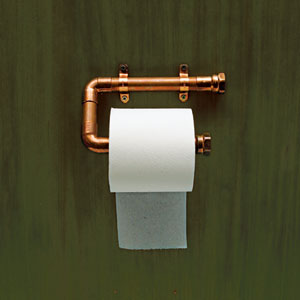
Photo: Mark Weiss
With scrap tubing selling for as much as $4 per pound, copper bits are worth recycling—if you had 'em by the truckload and if gas weren't $4 a gallon. Fortunately, a trip to the scrap yard isn't the only way to give new life to the odd end or fitting left over from your last DIY plumbing job.
1. Hold a roll. Copper gleams as a support for toilet paper. TOH technical editor Mark Powers made the one above out of tubing and various fittings. To keep its sheen, spray it with lacquer.
2. Protect plantings. Solder or caulk a copper cap to one end of a 16-inch-long tube, then drive the other end into the soil to keep the garden hose from dragging over your daylilies.
3. Make a wind chime. Cut various lengths of tube; the longer the piece, the deeper the sound, says Dale Powell of the Copper Development Association. Drill a hole an inch from their tops. Loop fishing line through the openings and hang from a wood disc.
4. Aim high. Connect assorted adapters and elbows to a length of ½-inch tubing to form a hooked staff. Screw a showerhead on the hook end and a garden hose on the other to make a watering wand for drenching hanging baskets.
5. Shim a post. Short offcuts pounded flat make durable outdoor shims. Depending on tubing gauge, shims will range from 1/16 inch to 3/32 inch thick.
6. Deck out a stair. Use 1-inch-diameter pipe instead of wood for balusters. Be sure to follow local codes for spacing. Left in the weather untreated, copper develops a verdigris patina.
7. Clean gutters. Pound flat the last 6 inches of a long length of tubing, then bend the tip to form a 90degree angle to rake out hard-to-reach muck.
8. Move mountains. Pyramid builders in ancient Egypt transported heavy stones by rolling them over pipelike cylinders—it works with overfilled trash cans, too.
9. Coax a climber. Make a rot-proof trellis out of tubing and fittings. Mount it on a wall or anchor it in the soil for a freestanding ladder for vines to grow on.
10. Clean up. Duct-tape copper tubing to the end of a vacuum hose to suck spiders from rafters. Don't run the vacuum for more than a few minutes, though, or the increased back pressure caused by the narrow, makeshift extension will strain the motor.
source: Mark Feirer, This Old House Magazine
http://www.guaranteedplumbingco.com

No comments:
Post a Comment